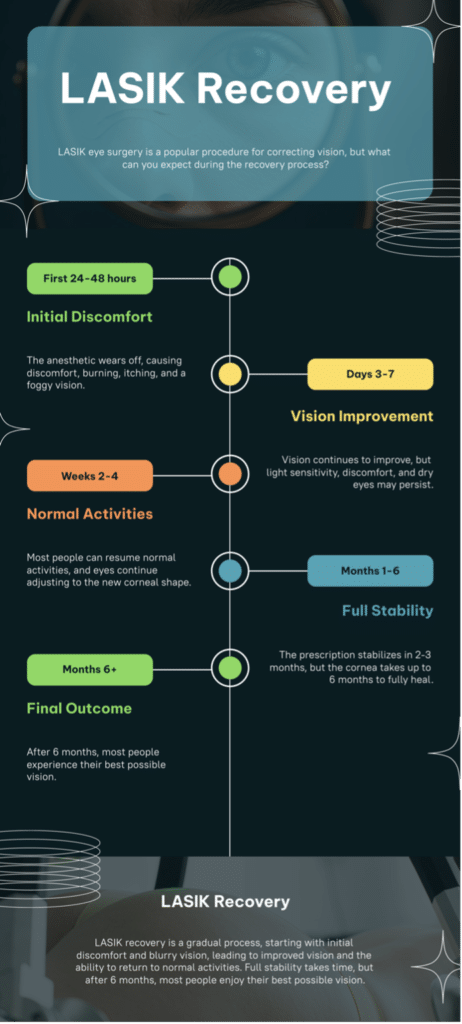LASIK eye surgery takes just 10 minutes to treat both eyes and has reshaped the scene for over 50 million people worldwide. The procedure is quick, but each person’s recovery timeline differs.
Most patients see clearer vision within 24 hours. The complete healing process can extend up to 6 months. Your eyes start healing right after surgery. Many people return to driving the next day. The first few weeks might bring temporary effects like blurry vision, dry eyes, or sensitivity to light.
Getting back to your daily routine matters. Our doctor-approved tips and strategies will help speed up your recovery safely. These guidelines ensure you get the best results from your LASIK surgery.
Understanding LASIK Eye Surgery Recovery Timeline

Your body starts its remarkable healing process right after LASIK surgery ends. Most patients see substantial visual improvement within 24-48 hours. Notwithstanding that, knowing the complete recovery timeline will help you set realistic expectations about your healing experience.
Normal healing phases after LASIK
LASIK recovery follows a predictable pattern:
First 24-48 hours: The anesthetic will wear off and you might feel discomfort, burning, itching, or sensation of something in your eye. Your vision will be foggy at first—patients often say it’s like “looking through a dirty window”. About 90% of your best possible vision should come during this phase.
Days 3-7: Your vision gets better each day. You might experience light sensitivity, mild discomfort, and dry eyes. A follow-up appointment with your doctor will check your healing progress.
Weeks 2-4: Most patients can go back to their normal activities by now. Your eyes keep adjusting to their new corneal shape .
Months 1-6: Full stability takes time. Your prescription usually reaches its final result in 2-3 months, but your corneas need up to 6 months to heal completely. Vision changes during this time are expected.
Why recovery speed matters
Good healing leads to the best visual outcomes. Your wound healing response after LASIK directly affects your refractive result and vision quality. On top of that, it helps you return to daily activities, work, and enjoy better vision sooner.
Your healing will be faster and have fewer risks when you follow aftercare instructions. The cornea’s healing process differs from other tissues because it lacks blood vessels, so proper care becomes crucial to long-term success.
Factors that affect your personal recovery time
Your recovery speed depends on several factors:
- Prescription strength: Stronger prescriptions need more laser energy, which might make healing take longer
- Age: Younger patients’ eyes tend to heal faster
- Pre-existing conditions: Recovery might take longer with dry eye syndrome or other corneal issues
- Surgical technique: Modern LASIK technologies often lead to quicker healing
- Adherence to aftercare: Your healing speed depends on how well you follow your doctor’s instructions
- Individual healing ability: Each person’s body responds differently to surgery
- Corneal thickness: This determines both who can have surgery and how long recovery takes
These factors help you understand what to expect from your personal healing experience. Note that while many people’s vision improves quickly, your body will heal at its own pace.
First 48 Hours: Critical Actions to Speed Healing
Your LASIK procedure’s success depends heavily on the first 48 hours of recovery. Every action during this time window can affect your comfort and final results. Here are the best ways to speed up your recovery while keeping your newly shaped corneas safe.
Immediate post-surgery care techniques
Your body needs rest right after surgery. Head home and close your eyes for 3-4 hours to start the healing process. The anesthetic will wear off in about 30 minutes, and you’ll likely feel some irritation, redness, and mild discomfort.
These activities can strain your eyes in the first two days:
- Reading, watching TV, or using digital devices
- Bright lights and direct sunlight (wear your provided sunglasses outdoors)
- Dusty or dirty environments
Eye shields protect your investment. These shields stop you from accidentally rubbing or touching your eyes. Your doctor will tell you when to wear them—usually all day for the first 24 hours, then at night for several days.
Sleep positions that prevent complications
Your best sleep position is on your back during early recovery. This keeps your eyes away from pillows and bedding that could disturb the healing corneal flap. Research shows better healing rates in this position.
Your safest approach includes:
- Elevated head position with pillows to reduce swelling
- Properly secured eye shields before sleep (vital if you share your bed with kids or pets)
- No ceiling fans or direct air on your face to prevent drying
- Six hours of sleep minimum to help corneal healing
Managing discomfort without compromising healing
Discomfort usually peaks between 24-48 hours. Your doctor will give you specific eye drops, including antibiotics to fight infection and anti-inflammatory medication to reduce swelling.
Solutions for common symptoms:
- Burning/foreign body sensation: Use prescribed artificial tears—keep them in the fridge for extra comfort
- Light sensitivity: Put on sunglasses and dim indoor lights
- Dry eyes: Use preservative-free lubricating drops regularly, even if your eyes feel fine
- Mild pain: Stick to doctor-approved pain relievers as prescribed
Remember, never rub your eyes, no matter how itchy they feel. This simple action can move the corneal flap and ruin your surgery results. Use extra eye drops instead for relief.
Days 3-7: Accelerating Your Recovery Process
Your healing speeds up and vision starts to stabilize between days 3-7 after surgery. You’ll notice your vision getting much better. The corneal swelling usually goes down during this time, which makes everything clearer day by day.
Eye drop application methods to get the best results
The right way to apply eye drops is vital during recovery. Here’s the quickest way to get the best results:
- Look up and tilt your head back slightly
- Pull your lower eyelid down gently to make a small pocket
- Put one drop in this pocket (don’t let the dropper touch your eye)
- Keep your eye closed without blinking for 30-60 seconds so the drop absorbs fully
Take your prescribed medications exactly as your doctor tells you. You’ll likely need antibiotic drops for 7-10 days and steroid drops for 1-2 weeks. Your doctor might suggest using preservative-free artificial tears every 2 hours, even if your eyes feel fine. Dry eyes can make your vision blurry and affect your surgery’s outcome.
Activity changes that help you heal faster
Stay away from these activities:
- Rubbing your eyes (this is vital for the first month)
- Swimming pools, hot tubs, and saunas (wait 2-4 weeks)
- Eye makeup (wait 7 days)
- Dusty places and gardening (avoid all week)
- Contact sports (wait 4 weeks)
You can safely start:
- Reading and light screen time (take breaks often and use eye drops)
- Walking (after 24 hours) and jogging (after a week)
- Wearing sunglasses instead of protective eyewear outdoors (from day 3)
Getting back to your normal routine
Most office workers can head back to work by day 3. If you use a computer, take frequent breaks and keep your eyes lubricated. You might be able to drive on day 2 if your vision meets legal requirements. Light workouts like exercise bikes or weights are usually fine by day 3.
Your follow-up appointment during this time is key. It lets your surgeon check your healing progress and adjust your recovery plan if needed.
Weeks 2-4: Advanced Recovery Optimization
Your corneal healing reaches a vital phase between weeks 2-4. Your nutrition, hydration, and environment play key roles in your recovery. Many patients see their vision become more stable during this time, but your cornea still needs special care to get the best results.
Nutrition strategies for corneal healing
The right nutrition can speed up your LASIK recovery and make it more effective. Your cornea needs specific nutrients to heal properly after surgery reshapes it.
Add these healing foods to your diet:
- Vitamin A (found in leafy greens, sweet potatoes) protects the cornea and conjunctiva
- Vitamin C (abundant in citrus fruits, kiwi, bell peppers) prevents photo-induced oxidative damage to ocular tissues
- Vitamin E (present in nuts, seeds) wards off cellular eye damage
- Omega-3 fatty acids (in fatty fish, flaxseeds) help ease dry eyes—a common side effect that affects 9 out of 10 patients
Protein helps repair tissue too. Eggs, chicken, and fish can help your cells and blood vessels recover. Your healing body also needs energy from complex carbohydrates found in whole grains.
Hydration’s role in vision stabilization
Good hydration helps ease dry eye symptoms and supports your recovery. When you stay hydrated, your eyes maintain their natural protective tear film.
Drink 8-10 glasses of water daily to keep your body and eyes hydrated. This simple habit can prevent dryness that causes vision changes during weeks 2-4.
Cut back on alcohol, coffee, and soda because they can make dry eye symptoms worse. About 60% of patients still have dry eyes one month after LASIK, so staying hydrated matters even more during this time.
Environmental adjustments for comfort and healing
Your environment affects how fast and comfortably you recover. Keep your space clean and free of dust and allergens to reduce infection risk and irritation.
Protect your eyes from UV rays by wearing sunglasses outdoors. Stay away from smoke, dust, or very dry places that can make your eyes feel worse.
By weeks 2-4, you can usually start:
- Swimming and using hot tubs (after 1-2 months)
- Wearing eye makeup (after 2 weeks)
- More physical exercises including tennis and even scuba diving
Contact sports like rugby, boxing, and martial arts are still not safe. Your surgeon will tell you which activities are okay based on how well you’re healing during your follow-up visits.
Conclusion
LASIK eye surgery can transform your life if you stick to proper recovery guidelines. Your vision becomes sharper within 48 hours. The complete healing process needs patience and dedicated aftercare that can last up to 6 months.
Doctor-approved recovery steps guide you toward success. You should protect your eyes during original healing, maintain good nutrition and hydration, and ease back into normal activities gradually. These proven strategies help you heal better and reduce complications.
Each person’s recovery is different based on prescription strength, age, and natural healing ability. Looking to get LASIK surgery? Precision Vision London’s free consultations are a great way to get details about your specific recovery timeline.
Your best outcomes come from following aftercare instructions carefully, especially in the critical first month. LASIK surgery can boost your daily life with lasting vision improvements when you take proper care and stay patient.
FAQs
Q1. How can I accelerate my recovery after LASIK eye surgery?
To speed up recovery, rest your eyes for the first 24-48 hours, use prescribed eye drops as directed, avoid rubbing your eyes, wear protective eyewear, and stay hydrated. Follow your doctor’s instructions carefully and attend all follow-up appointments.
Q2. When can I resume normal activities after LASIK?
Most patients can return to work within 2-3 days, drive after 24 hours if vision meets legal standards, and resume light exercise like walking after 24 hours. However, avoid swimming, contact sports, and using eye makeup for at least 1-2 weeks. Always consult your doctor for personalized advice.
Q3. What role does nutrition play in LASIK recovery?
Proper nutrition is crucial for optimal healing. Focus on foods rich in Vitamin A, C, E, and Omega-3 fatty acids. These nutrients support corneal health, prevent oxidative damage, and combat dry eyes. Also, ensure adequate protein intake for tissue repair and stay well-hydrated.
Q4. How long does it take for vision to stabilize after LASIK?
While most patients notice significant improvement within 24-48 hours, complete vision stabilization can take 2-3 months. Full corneal healing may require up to 6 months. Vision fluctuations during this period are normal, and following aftercare instructions is crucial for the best outcomes.
Q5. What precautions should I take to protect my eyes during LASIK recovery?
Wear protective eye shields as directed, especially while sleeping. Avoid dusty environments, direct sunlight, and activities that could lead to eye trauma. Use preservative-free artificial tears to combat dryness, even if your eyes don’t feel dry. Lastly, attend all follow-up appointments to ensure proper healing.
References
- https://www.fda.gov/medical-devices/lasik/what-should-i-expect-during-and-after-surgery
- https://www.medicalnewstoday.com/articles/what-to-know-about-lasik-recovery-and-its-effects
Authors & Reviewer
-
 Olivia: Author
Olivia: AuthorHi, I'm Olivia, a passionate writer specialising in eye care, vision health, and the latest advancements in optometry. I strive to craft informative and engaging articles that help readers make informed decisions about their eye health. With a keen eye for detail and a commitment to delivering accurate, research-backed content, I aim to educate and inspire through every piece I write.
-
 Dr. CT Pillai: Reviewer
Dr. CT Pillai: ReviewerDr. CT Pillai is a globally recognised ophthalmologist with over 30 years of experience, specialising in refractive surgery and general ophthalmology. Renowned for performing over 50,000 successful laser procedures.

